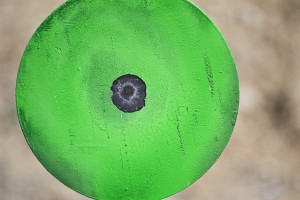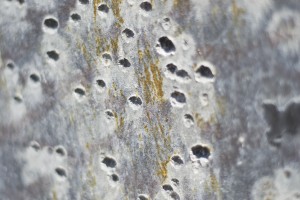When it comes to steel targets, it is important to understand there are crucial differences in the quality of the steel used to make the targets and the design of the targets themselves. In an age where it seems everyone “knows a guy” who can make steel targets for them out of a welding shop, understanding the facts about steel is even more important. Steel targets can be perfectly safe and a fantastic training tool if done right, but they can also be extremely dangerous if done wrong. Here at Action Target, we have been designing and manufacturing steel targets![]() and tactical training systems for nearly 30 years. Here are some of the things we’ve learned along the way.
and tactical training systems for nearly 30 years. Here are some of the things we’ve learned along the way.
TRUTH – THERE IS A SIGNIFICANT DIFFERENCE IN THE QUALITY OF STEEL BEING USED
Unfortunately, there are steel targets out there that are poorly designed and are made of inferior steel. Homemade targets from local welding shops are usually the culprits, but some commercial target manufacturers use inferior steel as well. Because these targets are vulnerable to cratering, pocking, and general deformation, they are very dangerous and should be avoided. Any steel with a Brinell hardness rating under 400 falls into this category, including standard “T-1” steel with a hardness rating in the 300 range.

After many years of experimenting to find the best solution, most major manufacturers of dependable, high quality steel targets now use steel with a Brinell hardness rating of at least 400. A few premium quality manufacturers use steel with a higher Brinell hardness rating of 500 or even 550. Fewer than 10 steel mills in the world can provide quality AR500/550 steel. Action Target has direct relationships with many of these suppliers which allows us to purchase steel mill direct. Steel of this quality is always certified by the plant that created it, however, at Action Target we conduct independent hardness testing on every shipment we receive. If the steel does not meet our ballistic standards, we reject the entire order and send it back.
Other steel certifications like “Magnum Steel” or “Extreme Steel” are merely marketing terms added by the manufacturer. When all the rhetoric is boiled away, there are manufacturers who use steel that is not appropriate for targets, and there are those who use steel that is. Make sure you know the difference.
PROPER DESIGN IS CRITICAL
Even the best steel can’t compensate for poorly designed targets. There are several unavoidable principles that must be followed to create targets that are as safe and durable as possible.
![PT Torso (all sides) [web]](https://www.actiontarget.com/wp-content/uploads/2013/05/PT-Torso-all-sides-web-300x300.jpg)
TRUTH – SMOOTH AND TOTALLY FLAT SHOOTING SURFACES ARE ESSENTIAL FOR CONSISTENT SPLATTER PATTERNS
There are two things manufacturers can do to ruin the smoothness and flatness of a steel target. First, they can use inferior steel that will crater, pock, and deform. Second, they can put brackets, clamps, or bolts in the way of the shooting surfaces. Remember, anything that can be shot will be shot. Why is this an issue? Because you can do a reasonable job of predicting and protecting against a bullet’s splatter pattern when it hits a flat, uniform surface. If the steel is damaged or if anything else is in the way, all bets are off. Bullet fragmentation and ricochet are inherent and acknowledged issues when shooting on steel targets. Proper target design helps you address those issues with the highest degree of safety possible.
TRUTH – DISSIPATING A BULLET’S ENERGY IS SAFER AND HELPS YOUR TARGETS LAST LONGER
When a bullet strikes a steel target that is completely stationary at a 90-degree angle, all the bullet’s energy goes directly to weakening that point on the steel. If the target is completely stationary but is positioned at less than a 90-degree angle, a portion of the bullet’s energy at impact is deflected rather than absorbed. If the target is positioned at slightly less than a 90-degree angle AND the target is able to move on impact, a much larger portion of the bullet’s energy is deflected rather than absorbed.
NO STEEL TARGET IS INDESTRUCTIBLE
Without exception, every steel target out there today can be damaged. Steel hardness and proper design can both be defeated by misuse and/or abuse of the target.
TRUTH – THE BASIC DESTRUCTIVE FORCE GENERATED BY BULLETS STRIKING STEEL TARGETS IS HEAT
Excessive concentrated heat alters the steel’s hardness properties and results in damage to the target’s face. The amount of heat generated is proportional to the speed of the bullet, which is why rifles cause more damage to steel targets than handguns.
TRUTH – RIFLE DISTANCE ON STEEL TARGETS IS NOT AN EXACT SCIENCE

No matter what anyone tells you, shooting a steel target with a rifle – even at 100 yards – can damage your target, even if it has a Brinell hardness rating of 550. You must be very careful about your choice of steel and ammunition! Even with 550 Brinell steel and the target mounted at a significant angle, some damage is still possible, even at 100 yards. For best results, use only steel targets![]() that are specifically designed for use with rifles.
that are specifically designed for use with rifles.
With so many complex variables like ammunition type, rifle manufacturer, barrel length, bullet velocity and so on, it is virtually impossible to establish a set distance for shooting rifles on steel targets. To determine what works best with your specific equipment, we suggest the following: Fire a test shot from 100 yards and then examine the target. If there is no damage, move in a few yards and fire another test shot. Repeat the process until you find the optimal distance for your combination of rifle and ammunition. Some people may be comfortable with a certain amount of dimpling on the steel. Minor damage to the shooting surface will not create a shooting hazard if you are shooting at 100 yards, but if can be very dangerous if you choose to shoot at close range with a handgun on the same target. Even if your steel targets have only minimal rifle damage, they should never be used for closer distance handgun training.
TRUTH – SHOTGUN SLUG DISTANCE ON STEEL TARGETS MEANS 100 YARDS MINIMUM
Shotgun slugs have the greatest potential for bodily harm to the shooter due to the sheer volume of lead that can be returned from damaged or poorly designed steel targets. Stay back!
TRUTH – FRANGIBLE AMMUNITION REQUIRES THE SAME QUALITY STEEL AS REGULAR AMMUNITION
Many types of frangible ammunition, particularly for rifles, are lighter than regular lead ammunition. Remember that lighter bullets can mean greater speed, which means more heat, which can mean damage to your steel target. Just because frangible ammunition is designed to break up on impact doesn’t mean the distance requirements do not apply. You should follow the exact same rules with frangible ammunition as you do with any other.
TRUST THE EXPERTS
When it comes to your safety, don’t settle for the advice of your local welder. Steel targets can be fun and safe as long as they are made of quality steel and designed to produce predictable splatter. In fact, steel targets can be one of the greatest tools for firearms training, but they have to be manufactured correctly. Shooting on poorly designed targets made of inferior steel can result in severe bodily harm. Here at Action Target, your safety is our biggest concern. We have decades of experience manufacturing steel targets, and we constantly conduct ballistic research to make sure the steel we use meets our standards and your expectations. If you are looking for a steel target, trust us to point you in the right direction.







What is the largest caliber you will be shooting at the target? For general handgun shooting I would use 3/8″ thick mild steel. It will not be very expensive, should handle most handgun rounds and should be easy to find at your local hardware store or steel supplier. Most of the targets listed above are from hardened steel, which will cost you more. It’s worth checking the price on the hardened steel though. I have shot 1/4″ thick mild steel plates with handgun rounds and had some deformation. I cannot recall the exact rounds that were fired at the plate though.
Jaclyn,
The army asked the same question of us a few years ago. They wanted to know why it was important to use hardened armor steel instead of mild steel. We conducted an experiment at one of the bases where we shot at mild steel. On the very first shot, the bullet came right back at the shooter and took his hat off along with a big of scalp. If it had been an inch lower, he would have died. The army immediately ended the experiment and decided that armor steel should be the standard for all of their metal targets.
Whether it’s rifle or handgun, you should NEVER shoot at mild steel. Mild steel is several times softer than armor steel and flexes when hit with a bullet which greatly increases the risk of ricochet. When a bullet hits armor steel, however, it completely shatters and does not have a chance to bounce back at the shooter. The other issue with mild steel is that it easily becomes deformed when shot. Once the shooting surface is no longer completely flat, it is impossible to predict the angle of the splatter or ricochet. Even with armor steel, once the shooting surface has any sort of deformation that affects the flatness, it should not be shot on.
1/4″ AR500 armor steel can handle most centerfire handgun rounds, but may become deformed if shot with .44 Magnum or .45. 3/8″ AR500 armor steel can handle all handgun calibers, but is still too soft for rifle rounds. 3/8″ AR550 armor steel easily handles all handgun calibers and can handle rifle ammunition under 3,000 fps from 100 yards.